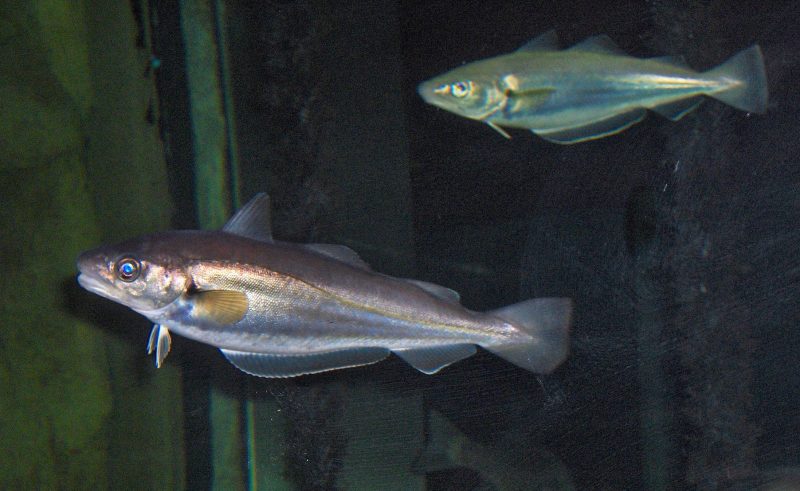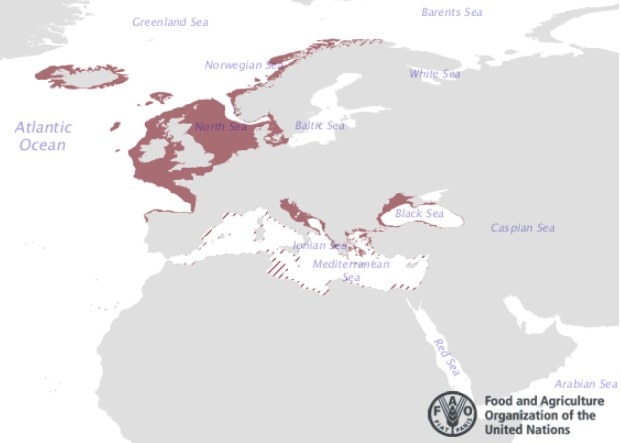Whiting

By Georges Jansoone (JoJan) – (Own work) [CC BY 3.0], via Wikimedia Commons
Scientific Name: Merlangius merlangus
Also Known As: Whiting
MCRS: 27cm
Description
Whiting is a cod like fish with an elongate body and a small head with a protruding upper jaw and a truncate (flat) tail. Its dorsal side is blue/green fading to silvery/white on the belly with a small dark spot on the base of the pectoral fins and a brown lateral line. They have three dorsal fins separated by gaps; the third fin extends almost to the tail which has a straight edge and is not forked. Generally adults are 25-30 cm in length but have been recorded up to 70 cm.
Habitat and Distribution

Whiting are found off the western coast of Scotland, south east England, in the English Channel and the Irish Sea. The species ranges from the North-eastern Atlantic to the South-eastern Barents Sea and from Iceland to Portugal in the Atlantic.
It is a bentho-pelagic species usually found at depths of 30-100m over a variety of substrates including mud, gravel, sand and rock.
Life Cycle, Reproduction and Feeding
Whiting feed on bottom-living organisms such as shrimps, crabs, polychaete worms, cephalopods and other small fish.
Whiting are a fast growing species reaching around 12 inches, and sexual maturity, by their second year. They have a high fecundity compared to other gadoids but with relatively small eggs, females of 30 cm in length can produce up to 400,000 eggs during the spawning season. Spawning takes place at a depth of 20-150 m, the timing of which varies depending on location, and occurs from January-September around UK coasts. Whiting spawn in batches, eggs are pelagic and larvae form part of the plankton until they reach around 10cm in length. Juveniles spend around one year in shallow waters up to 30m deep before migrating to adult feeding grounds after their first year. Juveniles have a chin barbel that often disappears upon maturity.
In the NWIFCA District
Whiting are fished commercially using nets or trawls. Whiting has increased in commercial value following the decline of other more traditional fish (such as cod). However the majority of whiting caught in the District is by-catch in small mesh fisheries such as the nephrops trawl fishery. ICES advice states that close to 98% of whiting catches are below the minimum conservation reference size for the species and are therefore discarded. Work is currently being carried out to review management options for whiting in the Irish Sea and to find solutions. Several technical measures have been introduced to both reduce finfish catch and discards in small mesh trawl fisheries however total discards remain high.
Whiting are also fished recreationally using rod and line. As they are growing, skinny and hungry, they are very attracted to fishing baits which can make them quite an easy catch!
Fisheries Management
Within the district there are Byelaws to restrict the use and dimensions of nets and trawls, as well as vessel specifications including engine size and vessel length. These vary in different locations. To read more about this click here.
There are also national and international measures that apply to this fishery, a precautionary annual total allowable catch (TAC) has been set for the species. TACs are divided up at an international level in the form of quotas and boats that are eligible are given a proportion of this quota and can fish for the species. Once the available quota has been fished the fishery is closed. To read more about this click here.
Where commercial trawling and netting occurs in Marine Protected Areas it undergoes an assessment to ensure the activity does not cause risk to conservation features. Habitats Regulations Assessments (HRAs) carried out for trawling and netting in the District’s European Marine Sites can be found here.